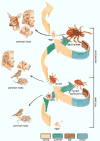Human babesiosis
- PMID: 18755385
- PMCID: PMC3998201
- DOI: 10.1016/j.idc.2008.03.010
Human babesiosis
Abstract
Human babesiosis is an emerging intraerythrocytic infection caused by protozoal parasites transmitted by ixodid ticks. Babesiosis is endemic in the northeastern and upper midwestern regions of the United States and is found sporadically in other parts of the United States, Europe, Asia, Africa, and South America. Babesial infections range from asymptomatic to severe and occasionally are fatal. Specific laboratory diagnosis of babesial infection is made by morphologic examination of Giemsa-stained blood smears, serology, and amplification of babesial DNA using polymerase chain reaction. The combination of atovaquone and azithromycin is the treatment of choice for mild-to-moderate illness, whereas clindamycin and quinine and exchange transfusion are indicated for severe disease.
Figures
References
-
- Babes V. Sur l'hemoglobinurie bacterienne du boeuf. Comptes Rendus Acad Sci. 1988;107:692–694.
-
- Smith T, Kilborne FL. Bur Anim Indust Bull. US Dept Agr; 1893. Investigations into the nature, causation, and prevention of Texa or southern cattle fever; pp. 177–304.
-
- Levine ND. Progress in taxonomy of the Apicomplexan protozoa. J Protozool. 1988;35(4):518–20. - PubMed
-
- Skrabalo Z, Deanovic Z. Piroplasmosis in man; report of a case. Doc Med Geogr Trop. 1957;9(1):11–6. - PubMed
-
- Fitzpatrick JE, Kennedy CC, McGeown MG, et al. Human case of piroplasmosis (babesiosis) Nature. 1968;217(5131):861–2. - PubMed



